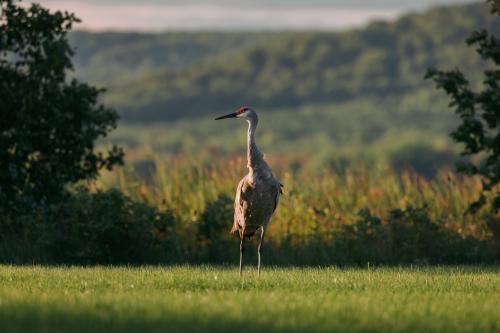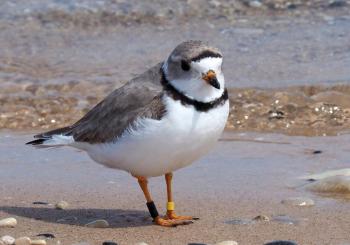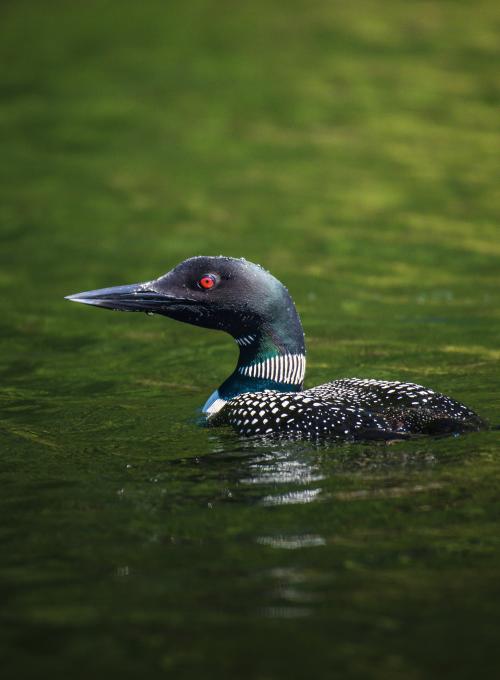Full-fledged birders and novices alike will find a wonderland to explore in the Sleeping Bear Dunes National Lakeshore. It consists of a combination of migratory flyways and diverse protected habitats—71,000 acres of public land and 35 miles of beaches, complete with public access.
 For me, a passion for birding started this spring, by simply paying more attention to the various species that live or pass through our neck of the northern Michigan woods. One bird that always broadcasts itself rather loudly: the Pileated Woodpecker, whose almost comical drumming on trees in the woods carries long distances. (Turns out woodpeckers drum in the spring for similar reasons that songbirds sing—to attract a mate and protect their nesting territory.)
For me, a passion for birding started this spring, by simply paying more attention to the various species that live or pass through our neck of the northern Michigan woods. One bird that always broadcasts itself rather loudly: the Pileated Woodpecker, whose almost comical drumming on trees in the woods carries long distances. (Turns out woodpeckers drum in the spring for similar reasons that songbirds sing—to attract a mate and protect their nesting territory.)
As a new bird watcher, I wanted to better understand the preferred habitats of various species, and whether I was more likely to spot certain birds on a walk in the woods or along the shore. The beauty of the Sleeping Bear Dunes, of course, is that there’s an opportunity for both.
I checked in with Vince Cavalieri, Wildlife Biologist with the Sleeping Bear Dunes National Lakeshore, for his take on the more interesting and easy-to-see birds within the park. Here’s what the expert has to say:
 Piping Plover - These are federally endangered species and thus are intensively managed and protected. Sleeping Bear Dunes has roughly 1/2 of the entire Great Lakes breeding population. While Piping Plovers can be secretive and their plumage helps camouflage them in their sandy beach habitat, they can still be relatively easy to see at the Lakeshore in the right habitats. Park biologists protect their nesting colonies and close certain areas of the beach to help them successfully fledge their chicks each season. They ask that all beachgoers respect these closed areas and watch the plovers from afar. Be sure that you’re looking at a Piping Plover and not one of its look-alikes. The Sanderling is similarly light-colored but has a smaller head and a longer, thinner bill.
Piping Plover - These are federally endangered species and thus are intensively managed and protected. Sleeping Bear Dunes has roughly 1/2 of the entire Great Lakes breeding population. While Piping Plovers can be secretive and their plumage helps camouflage them in their sandy beach habitat, they can still be relatively easy to see at the Lakeshore in the right habitats. Park biologists protect their nesting colonies and close certain areas of the beach to help them successfully fledge their chicks each season. They ask that all beachgoers respect these closed areas and watch the plovers from afar. Be sure that you’re looking at a Piping Plover and not one of its look-alikes. The Sanderling is similarly light-colored but has a smaller head and a longer, thinner bill.
Bald Eagle - Our national bird can be relatively easy to see at Sleeping Bear Dunes. Look for them soaring high above nearly anywhere in the park or look for them perched on top of large white pines near water.
Sandhill Crane - Sandhill Cranes breed throughout the Park but can be easiest to spot in open areas like Port Oneida or near large wetland complexes. Watch for them slowly walking through large fields or on the edges of ponds and lakes searching for prey.
Trumpeter Swan - Once extirpated from the eastern United States, Trumpeter Swans have been successfully reintroduced at many locations, including Sleeping Bear Dunes. These large white swans can be seen on any of the large inland lakes and even some ponds in the park where they raise their young, called cygnets.
 Common Loon - Common Loons are relatively rare at the park but a few pairs call our inland lakes home. Watch for them on the larger inland lakes, or listen for their haunting calls at dawn and dusk. Loons are sensitive to human disturbance so please keep your distance.
Common Loon - Common Loons are relatively rare at the park but a few pairs call our inland lakes home. Watch for them on the larger inland lakes, or listen for their haunting calls at dawn and dusk. Loons are sensitive to human disturbance so please keep your distance.
American Woodcock - These “shore” birds don't like the shore at all! American Woodcock instead occur in upland areas where they can forage on the ground in wet woods or on the edge of wetlands. Using their long bills to probe for worms and other invertebrates in the soil. In April and May, American Woodcocks do their sky dance displays in large open areas at dusk. A good place to look and listen for this is Port Oneida, but other large open fields also will host them.
Cavalieri also recommends trying to catch the dawn chorus.
The early bird really does get the worm in this case: Sleeping Bear Dunes features some of the best dawn choruses in the state. It takes some work to learn all the different songs that make up a dawn chorus at Sleeping Bear Dunes, but visit a beech-maple forest at dawn in early summer and you can hear many of the premier singers of the eastern forests including Wood Thrush, Veery, Winter Wren, Rose-breasted Grosbeak and Scarlet Tanager.
If you get really into keeping track of bird sightings, Sleeping Bear Dunes has a checklist of the wide range of different birds throughout the National Lakeshore.
Many amateur birders can up their game by following Ebird.org a database created by the Cornell Lab of Ornithology with real-time bird data. Also handy: ebirdhotspots.com shows a crowdsourced list of current birding hotspots in Leelanau County.
Birder bonus points? Cavalieri says some pretty and unique—but harder to spot—birds in include Prairie Warbler, a state threatened species that has its Michigan stronghold at Sleeping Bear; the black-throated blue warbler (a specialist of old-growth beech-maple forests); and Upland Sandpiper, which breed in the large open areas of Port Oneida and the old farm complex around Aral Road.
